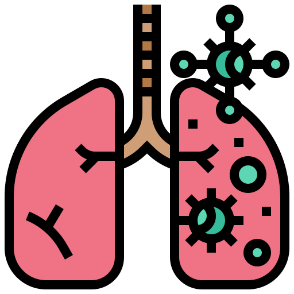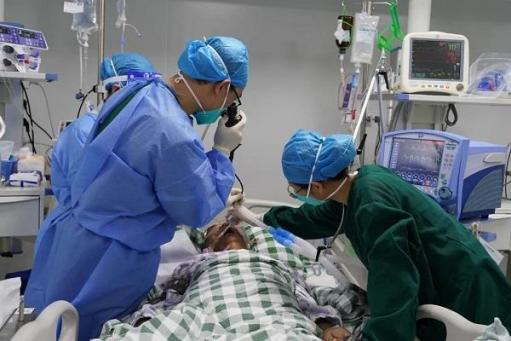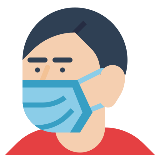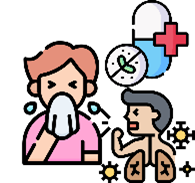Learning Modules
Module 01
Three common preventable infectious respiratory diseases
01. Definition of three common preventable infectious respiratory diseases and their pathogens
Three common preventable infectious respiratory diseases are:
| Three common preventable infectious respiratory diseases |
 Coronavirus disease 2019 (COVID-19)
Coronavirus disease 2019 (COVID-19)
|
 Influenza (Flu)
Influenza (Flu)
|
 Pneumococcal Infection
Pneumococcal Infection
|
|---|---|---|---|
| Definition | COVID-19 caused by a new coronavirus called Severe Acute Respiratory Syndrome Coronavirus 2 (SARS-CoV-2) | Acute respiratory illnesses caused by influenza virus | Mostly refers to illnesses caused by Streptococcus pneumoniae (or pneumococcus) |
| Pathogens |
Alpha - B.1.1.7 Beta - B.1.351 Gamma - P.1 Delta - B.1.617.2 Omicron - B.1.1.529 |
Type A - H1N1 (pdm09) & (H3N2) Type B Type C |
Over 90 serotypes of Streptococcus pneumoniae |
02. Prevalence of three common preventable infectious respiratory diseases in Hong Kong
2.1. Coronavirus disease 2019 (COVID-19)
The first local case was confirmed on 23 January 2020 and there have been five waves of outbreaks since then.
According to the statistics of the Department of Health, as of 29 January 2023, there were a cumulative total of 1,226,467 cases with positive SARS-CoV-2 nucleic acid test results and 1,880,112 cases with positive rapid antigen test results in Hong Kong, representing an incidence rate of 25.4%.
| Outbreak | Period | Strains of the virus |
|---|---|---|
| 1st | Late January to late February 2020 | S、L、O |
| 2nd | Mid-March to late April 2020 | G |
| 3rd | Early July to late September 2020 | GR1、GR2 |
| 4th | Late November 2020 to late May 2021 | GH、GV、N501Y |
| 5th | Late December 2021 to 28 February 2023 | Omicron, Delta |
2.2. Influenza
- In Hong Kong, influenza is most common in winter (January to March) and summer (July to August).
- According to the World Health Organization, the prevalence of influenza worldwide is estimated to be 5-10% in adults and 20-30% in children. It causes respiratory problems leading to death cases between 290,000 and 650,000 each year.
- According to the Centre for Health Protection (CHP), as of 4 November 2023, there were 21,988 influenza cases.
| Types of Pathogens | Infection |
|---|---|
| H3N2 and H1N1 viruses (both Influenza A viruses) | Outbreaks have been imposing stress and burden to the society |
| Influenza B virus | Impose a potential threat |
| Influenza C virus | Generally considered less likely to cause an outbreak |
2.3. Pneumococcal Infections
- Diseases caused by Streptococcus pneumoniae occur monthly.
- The peak season for the disease is from winter to spring.
- According to the data from the Centre for Health Protection (CHP), a total of 492 pneumococcal infections were recorded in Hong Kong from 2018 to March 2023.
- The incidence of invasive pneumococcal disease in Hong Kong ranged from 0.34 to 2.54 per 100,000 persons, with higher incidence rates in people aged 2-4 and aged 65 and above.
03. Symptoms of three common preventable infectious respiratory diseases and their differences
| Same Symptoms | ||||
|---|---|---|---|---|
 Fever Fever |
 Cough Cough |
 Weakness Weakness |
 Headache Headache |
 Nausea or vomiting Nausea or vomiting |
| Differences in Symptoms | |||
|---|---|---|---|
| Coronavirus disease 2019 | Influenza | Pneumococcal Infection | |
|
|
|
|
04. Complications of three common preventable infectious respiratory diseases
4.1. Coronavirus disease 2019
According to the BMJ, the time of onset for COVID-19 complications is varied. The likelihood and susceptible populations of complications are shown in the following table:
| Complication | Post Intensive Care Syndrome (ICU) | Blood clots | Cardiovascular complications | Acute renal injury | Acute liver injury | Neurological complications | Pregnancy-related complications | Cardiac arrest | Acute hair loss | Acute respiratory failure | Gastrointestinal complications |
|---|---|---|---|---|---|---|---|---|---|---|---|
| Likelihood of complication | High | Medium | Low | ||||||||
| Susceptible populations | Patients receiving treatment in intensive care units | Males, obese, Patients receiving treatment in intensive care units | Older adults, People with hypertension, underlying cardiovascular diseases and chronic renal diseases | Males, older adults, with a history of smoking, obese, with hypertension, diabetes, lung disease, etc. | Older adults, patients with liver disease | Children and adolescents | Pregnant women | Older adults | Female | Children | People with history of gastrointestinal bleeding and using anticoagulant medication |
According to the World Health Organization (WHO), complications of COVID-19 may lead to death. These complications may include: respiratory failure, acute respiratory distress syndrome, sepsis and septic shock, thromboembolism and/or multi-organ failure, including the heart, liver or a kidney injury.

4.2. Influenza
Influenza complications are less common but can occur occasionally. The complications include pneumonia, worsening of respiratory symptoms in patients with asthma or Chronic obstructive pulmonary disease, secondary bacterial infections, and heat cramps in young children. Rare but fatal complications: inflammation of the heart muscle (myocarditis), inflammation of the brain tissue (encephalitis), and inflammation of the peripheral nerves (Guillain-Barre syndrome).
4.3. Pneumococcal infections
Pneumococcus can cause different types of diseases; more common ones are pneumonia and otitis media. It can lead to invasive pneumococcal disease resulting in a serious or even fatal condition.
Symptoms depend on the site of infection:
- Otitis media: The infection can present with fever, ear pain and sometimes with discharge. It may lead to hearing loss in recurrent infection.
- Pneumonia: There may be shortness of breath, fever, cough with phlegm and chills; death may occur in severe cases.
- Meningitis: Neck stiffness, fever and confusion may occur. It may result in long-term hearing loss or even death.
- Sepsis and bacteremia: There may be chills and joint pains, and there may be concurrent infections in other parts of the body, e.g., meningitis and pneumonia.
05. Long-term health effects of three common preventable infectious respiratory diseases
| Coronavirus disease 2019 (Long COVID) | Influenza | Pneumococcal infections |
|---|---|---|
|
|
May result in spasticity, epilepsy, mental retardation and hearing impairment in children |
06. Health advice for infected persons
 |
Persons at high risk, such as those who are immunocompromised, with older age or health problems, or those with COVID-19 symptoms, should seek medical advice as soon as possible. |
|---|---|
 |
People with symptoms should stay home and rest, avoid going out. |
 |
Those with no symptoms are free to go out or work. |
 |
Students who have tested positive should not go to school until they obtain negative results in rapid tests. |
 |
Infected persons should wear well-fitting surgical masks during the first five days after testing positive. Without wearing masks, they should avoid having contact with other people (e.g., having meals at the same table) and going to crowded places or attending mass gatherings to lower the risk of transmission. |
 |
|
07. Impact on persons who are immunocompromised
| People with chronic diseases | People aged 60 years and above | Pregnant women | Children |
|---|---|---|---|
|
|
|
|
Anyone can get sick, become seriously ill or die from the above three common preventable infectious respiratory diseases!
08. Mode of transmission and detection methods of three common preventable infectious respiratory diseases
8.1 Modes of transmission
- Three infectious respiratory diseases virus can transmit via droplets from the respiratory tract (within 2 meters), touching the surfaces or objects contaminated with the virus.
- COVID-19 can spread via short distance aerosols* or airborne transmission. The virus may also be transmitted in poorly ventilated and/or crowded indoor environments.
- Incubation period are estimated to be 1 to 14 days for COVID-19. Some variants may have a shorter incubation period#, such as the Omicron variant, which has an incubation period of about 3 days.
- An infected person can be contagious and can transmit the virus to others, regardless of whether they have the disease or not.
*Aerosols is one form of airborne transmissions, but airborne transmission is not necessarily via aerosols. Its size is around 5 to 10 microns and can float in the air from a few minutes to a few hours, and at a distance of up to around 10 meters. Aerosol transmission usually takes place in confined environments (e.g., in lifts, cruises).
#The incubation period is the time between an infection and the onset of clinical symptoms of the disease.

8.2. Viral infection detection methods
| Principle of detection | How the test is performed | Waiting time for results | Advantages and disadvantages | Types of infectious respiratory diseases | |
|---|---|---|---|---|---|
| Nucleic Acid Amplification Test (NAAT) | Detect genetic materials (RNA) | Virus Saliva, or nasal mucosa or throat sampling | Same day (20 minutes to a maximum of 3 days) | Very high accuracy, but relatively expensive |
|
| Rapid antigen test | Detect the surface proteins (or antigens) of pathogen | Nasal mucosa or throat sampling | About 15 minutes | Fast, convenient and inexpensive; sensitivity is usually low |
|
| Antibody test | Test the antibodies produced by the body's immune system | Finger-prick blood collection or blood drawn from the arm | Same day up to a maximum of 7 days | Provides an indication of the level of antibodies in the body but it should not be used to diagnose current infection status and should not be used as an immunity test |
|
| Blood Tests | A sample of blood is examined or used to culture bacteria to identify the pathogens and assess the disease | Finger prick or blood drawn from a vein in the arm | NA | Blood tests are easily available, simple, inexpensive, high specificity; and low sensitivity |
|
References
L. Bourouiba, E. Dehandschoewercker, and J. W. Bush"Violent expiratory events: on coughing and sneezing,"Journal of Fluid Mechanics, vol. 745, pp. 537-563, 2014
Wang Q, Lung DC, Chan PT, et al"High attack rate in a Tong Lau house outbreak of COVID-19 with subdivided units in Hong Kong."Interface Focus. 2022;12(2):20210063. Published 2022 Feb 11. doi:10.1098/rsfs.2021.0063



